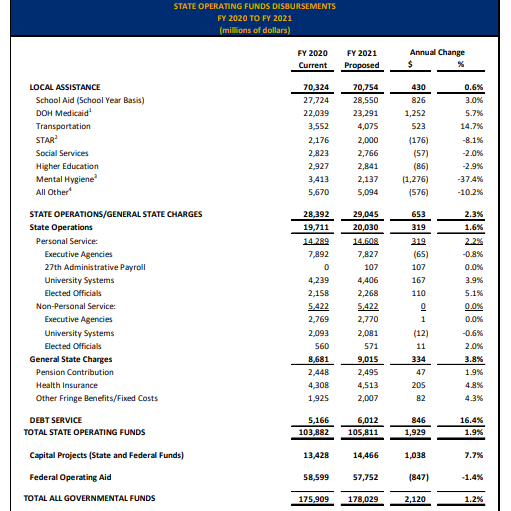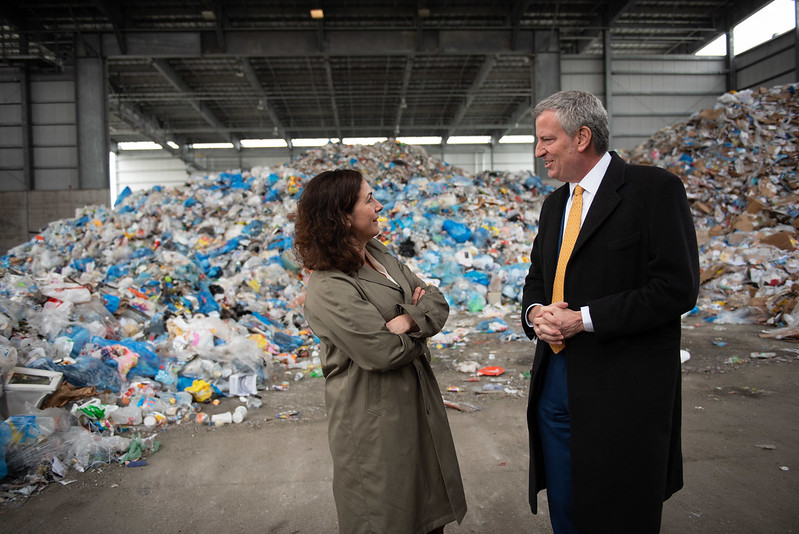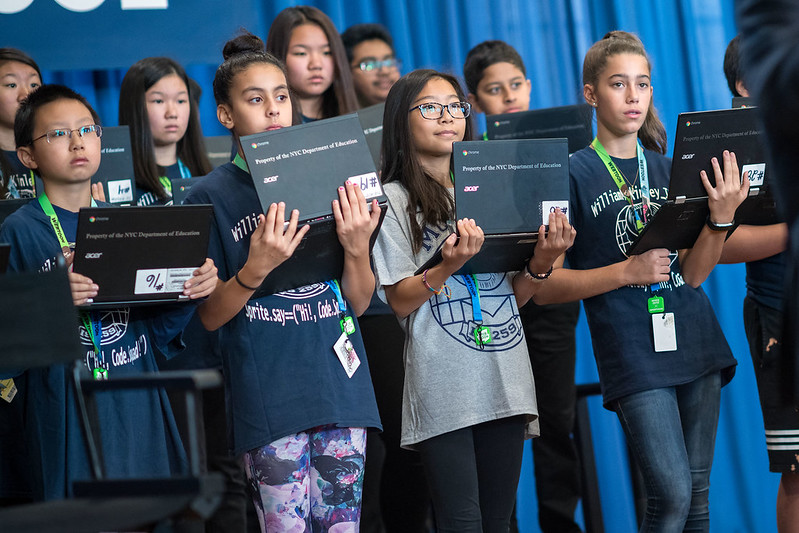State Budget Includes Extensive Cutbacks But We Don’t Know What They Are Yet

Governor Cuomo gives a budget presentation (photo: Kevin P. Coughlin/Governor's Office)
New York State and City are the gruesome public health epicenter of COVID-19, with horrific daily death tolls. The coronavirus is likely causing New York to also be the economic epicenter of the nation’s staggering job and economic loss, although those are statistics that will play catch up.
New York State’s fiscal year is April 1 to the following March 31, so the Governor and the Legislature just adopted a new budget (slightly late on April 3), just weeks after the national shutdown in mid-March, leaving little time to determine how the virus would affect the state’s economy and tax revenue. Several federal bailout bills were passed before New York adopted its budget, but Governor Cuomo bitterly complained New York was badly shortchanged in those bills and was among those calling for a fourth such package with significant aid to states and localities.
The National Governors Association (Gov. Cuomo is the Vice-Chair) just asked Congress for another $500 billion for state governments alone, not even including local governments.
The adopted New York state budget recognized revenues would plunge with the declining economy, and set targeted painful spending reductions without specifying exactly what they would be. The Budget Director is supposed to establish a plan for the spending reductions. The State Legislature authorized the creation of processes for remote voting even as it passed the budget two weeks ago, so that it could continue to make decisions without returning to Albany. But where the budget is headed is still uncertain; what’s really needed is another federal bailout package.
The state budget authorized a reduction of $10 billion, or about 10%, from what had been the initially submitted Financial Plan for $105.8 billion in state operating funds, the core of the budget funded with state dollars. The spending reduction will bring State Operating Funds to $95.8 billion. Some parts of the budget were exempted from cuts, meaning other parts might have to take cuts larger than 10%.
Below is a table showing how that $105.8 billion was proposed in January to be distributed, in the column FY 2021 PROPOSED. The Financial Plan to be released after budget adoption has not yet been published, but the spending parameters will be similar to what was submitted. The $10 billion cut will have to be taken from the programs in that column.

The State law directing the $10 billion reduction prohibits cuts to public assistance benefits and income supplements for the aged and disabled. It also prohibits cuts to debt service, contractual obligations, and spending pursuant to court orders or judgments. That means pensions and health insurance for state employees and retirees could likely also be exempt from cuts in the short-term, in addition to debt service and public assistance.
Spending in other vital areas, like pre-K to 12 education, higher education, Medicaid, social services like child care and child welfare, public safety, or transportation, could take the brunt of the cuts, to the extent funding is not backfilled by what has already passed Congress.
The $10 billion cut, however, is potentially just the first reduction. The budget permits the Director of the Budget to reduce spending again at three intervals over the course of the year, depending on how much revenue is coming into the State Treasury. The Legislature must receive ten days notice before any new cuts, and has that time to override them, by concurrent resolution of both houses. The new remote voting procedures would enable the Legislature to do that without returning to Albany. Robert Mujica, the budget director, estimated revenue losses could reach $ 15 billion, but nobody knows right now. If the economy declines further than the initial estimate, cuts could be even more severe.
Implementation Lacks Transparency, Budget Plan Should Be Disclosed Says Citizens Budget Commission
Critical decisions include how the federal bailout funds are used, what gaps remain after federal funds are used, and what the choices for cutting will be where there is no federal relief. There also probably won’t be one set of decisions, but many over a number of months.
Congress has already passed several bailout bills, which have included estimates of about $1.1 billion for education for New York and Medicaid spending relief estimated at $4.5 billion. A general state and local relief package included $7.5 billion for New York State, but the state government must share those funds with local governments and the share reserved for the state government itself was estimated at $3.1 billion. Separate appropriations for hospitals were also included in the federal bailout. But it’s clear these federal funds won’t make up for New York’s adopted cutbacks, let alone any new ones.
Below are several critical aspects of the state budget framework:
New York Medicaid Cuts Partially Adopted, But Postponed to Access Federal $
Governor Cuomo had set up a Medicaid Redesign Team at the beginning of the budget process to ratchet down exploding Medicaid spending, and on March 19 the team recommended $1.6 billion in cuts to and savings from the program. But the federal Medicaid relief package prohibited states from using the funds while cutting their Medicaid programs. The enacted state budget permitted the Division of the Budget to delay implementation of the Medicaid cuts to take advantage of the federal funds. But the federal financing expires in a year; right now the cuts would go forward next year, absent further changes.
Tax Filing Deadline Postponement Hurts New York Cash Flow; Budget Allows $8 Billion in Borrowing and $3 Billion Line of Credit
In April 2019, according to New York State Comptroller monthly cash reports, New York ran more than a $6 billion surplus in its State Operating accounts, primarily due to the April filing of New Yorkers’ tax returns. But New York will not have that luxury now. Federal and State tax return filing deadlines have been delayed from April 15 until July 15, putting New York’s cash flow into a precarious condition and delaying critical information on revenue to the state’s leadership.
The economy’s downward plunge cannot be tracked with normal tools. A decision to borrow up to $11 billion is mind-boggling, but essential to avoid a collapse of New York’s government and a good decision. The budget permits the short-term borrowing to be extended next year, or even converted into a long-term borrowing, which would be tantamount to borrowing to pay for operating expenses, a bad practice but we are in an emergency and interest rates are very low.
What’s Missing? Public Disclosure in Real Time
The state budget over the next several months will undoubtedly be a series of halting and difficult steps with no easy decisions. But the public deserves a regular process of disclosure of what choices are being made step by step. That includes state cuts, federal backfills, and state borrowing.
The adopted Financial Plan is not yet even public, and normally there would be a 1st quarter update released sometime after June 30 (the end of the 1st quarter). Last year the 1st quarter update was not released by the Division of the Budget until August. But now critical decisions will be ongoing within a few weeks and continue for months. The Governor and the Division of the Budget have an obligation to disclose such vital information in real time, not after the fact. If the situation improves and cuts can be restored, that will be good news.
***
Jim Brennan was a member of the New York State Assembly for 32 years, where he chaired four committees. On Twitter @JimBrennanNY.
***
Have an op-ed idea or submission for Gotham Gazette? Email This email address is being protected from spambots. You need JavaScript enabled to view it.
Fighting Climate Change and Offering Good Green Jobs: New York City Must Save Its Recycling and Organics Composting Programs

Mayor de Blasio at a garbage facility (photo: Michael Appleton/Mayor's Office)
Even as the global COVID-19 shutdown produces fortuitous environmental benefits such as cleaner air due to a huge decline in travel, the U.S. Environmental Protection Agency is cynically using the pandemic to justify backtracking on pollution standards and enforcement, easing a path for climate change and related catastrophes to continue unabated. This is deeply concerning. By some measures, last winter was the warmest ever recorded, and the 2020 hurricane season is expected to be more active and dangerous than normal.
Sustainable waste management remains one of the vital environmental policy areas in which municipal and state governments retain full control. As New York City enters a budget process filled with painful choices, the mayor should rethink the hasty decision to suspend compost collections, and should preserve the Department of Sanitation’s (DSNY) organic waste recycling programs. These are critical local climate change initiatives that also provide good, green jobs our communities will desperately need during this recession.
Food scraps, food-soiled paper, and yard waste comprise more than one-third of what New Yorkers throw out, and residential food waste will likely increase as more people eat at home during the emergency. When buried in landfills, as most of this material is, these organic materials emit methane, a greenhouse gas about 30 times more potent than carbon dioxide. Modern organics composting and recycling facilities can transform food scraps and other organic waste into a nutrient-rich soil or fertilizer and renewable energy sources – but only if we sort and collect organic waste separately from other recyclables and trash. Without continuing and expanding our organics recycling capacity, we won’t be able to move the needle on this major greenhouse gas source anytime soon.
Composting and recycling waste also create and sustain far more jobs than exporting garbage to landfills and incinerators. Although relatively small, New York City’s organics programs already employ more than 100 uniformed sanitation workers in collections alone, in unionized jobs where safety, training, and benefits are available. Dozens more workers are employed at food scrap drop-off sites, local composting facilities, and in other green jobs. Rather than hastily axing these positions, we should view sustainable waste management as a green jobs pipeline at a time when New Yorkers are struggling more than ever.
While recycling is often an easy target for cash-strapped local governments facing a grim fiscal picture, recycling programs cannot simply be switched back on after the economy recovers. Temporary suspension of activities that place our heroic sanitation workers at any additional risk of infection may be necessary, but the cuts to compost collection appear more long-term. Successful diversion programs require widespread public participation, years of ongoing education, and behavior changes by millions of individuals and businesses. Note that the city has only just started to approach the recycling levels achieved two decades ago before Mayor Bloomberg suspended metal, glass and plastic recycling in the aftermath of 9/11.
New data suggest that New Yorkers want to keep composting and recycling during this crisis. In March and the first week of April, residential compost collections continued unabated in the communities where the program is well-established, and New Yorkers separated more food scraps in their brown compost bins this March than they did in March 2019.
Other cities, including San Francisco and Seattle, have continued to treat compost collection as an essential service, despite implementing some of the strictest stay-home orders in the nation. Early reports suggest residents and businesses continue to diligently separate food scraps, yard waste, and other recyclable materials.
We know our leaders care about recycling too. In recent years, the Sanitation Department, the City Council, and the Mayor’s Office have taken critical steps to expand and normalize organic waste recycling. By last year, Sanitation was collecting and recycling about 250 tons of organic material per day. The city is also poised to require and incentivize greater participation in food waste recycling by businesses, using a new commercial waste zones system. Several elected officials have emerged as champions of organics recycling and sustainable waste management, including City Council Member Antonio Reynoso, who chairs the Council sanitation committee, and Speaker Corey Johnson, both of whom fought to pass the landmark commercial waste zones bill and have called for citywide, mandatory food scrap recycling.
These programs should be seen as essential services, cornerstones of our climate mitigation strategy, and a source of good jobs for communities that will desperately need them. New York City must prioritize our recycling and organics composting programs.
***
Justin Wood is Director of Organizing and Strategic Research at New York Lawyers for the Public Interest. On Twitter @NYLPI.
***
Have an op-ed idea or submission for Gotham Gazette? Email This email address is being protected from spambots. You need JavaScript enabled to view it.
Coronavirus Widens Digital Divide, But Creates Opportunity to Finally Bring All Into 21st Century

Students and laptops, eyeing the digital divide (photo: Ed Reed/Mayoral Photography Office)
Among the many lessons the coronavirus outbreak is teaching us about our society is that we are not prepared to live in the 21st century, particularly residents in low-income communities with little or no access to much-needed technology.
This century is a time of continued uncertainty, in which established norms change overnight and disruptions are being regularly caused by natural and man-made disasters. Our largely interconnected globe means that the spread of information, goods, and diseases can occur with lightning speed.
We’re in the midst of another technological revolution that is dramatically changing how people shop, communicate, work, and learn.
But even before the coronavirus pandemic, not everyone had been part of the changes that have been occurring in the 21st Century. And those discrepancies have come into full relief, and been exacerbated, as COVID-19 has led to school and workplace closures.
Consider the implications of the “stay at home” orders requiring K-12 schools, colleges, and universities to move education from in-person to remote, online learning.
Many educators are ill-prepared to teach online; many students are unable to connect for their online classes. In New York City, a million households lack access to the Internet and, if they have a connection, it is often at speeds too slow for effective online education. Nearly 300,000 students in the New York City public schools have no computer or tablet of their own to access the Internet. In an age where companies have enormous amounts of data on individuals, the New York City Department of Education had no idea which students have access to the Internet or own a computer or tablet -- the city is now promising all who need them will have them seven weeks after school buildings were closed due to the pandemic. How can the DOE plan for a crisis without this kind of imperative data? The same can be said about the challenges faced by public colleges and universities.
The Center for an Urban Future recently reported the tech sector in New York City has been expanding faster than the number of available skilled personnel to fill the jobs. To qualify for these high-paying jobs requires education and the development of special skills – such as critical thinking, complex problem solving, teamwork, and the ability to work under uncertain conditions. The report further identified the underrepresentation of youth from low-income communities in the tech sector. The move to online education, however long it may last, reinforces the gaps for low-income communities, and shines a bright spotlight on the fact that students’ lack of access to the Internet and the equipment needed to access it are key reasons why these same young people can’t acquire the skills and knowledge needed for the 21st Century economy.
For all practical purposes, we have a system accessible only to those who can pay for access. In the 21st century, everyone needs access to a computer or tablet and connectivity to the Internet to make their way in life. For most, the only option is paying a private provider – this is not a viable option for many low-income families.
It is time to stop thinking of the Internet as a private good available only to those who can pay. Instead, the Internet needs to be viewed as a public good accessible to all, independent of ability to pay. As a public good access to the internet has to be extended to all households, independent of their ability to pay. Efforts in New York to accomplish this through charter agreements with cable companies have proven ineffective. The enormous federal funding allocated to address the many issues raised by the coronavirus pandemic provides opportunity for achieving an essential goal: completing the nation’s “Information Highway,” or Internet network. Speaker Nancy Pelosi has indicated the House of Representatives is considering such an effort in a new infrastructure bill. Once the internet is available throughout the U.S., providers need to develop service plans that provide low-income communities, whether urban or rural, access to basic services at an affordable cost.
Life is not going to return to the way it was before the coronavirus. More people will work, learn, shop, and play using varied online tools, and more remotely than ever.
Bringing all Americans into the information age will require a momentous effort on the scale of the federal project that brought electricity to darkened regions of the country during the New Deal. The coronavirus has made it clear that completing the Information Highway, making it accessible to all, independent of ability to pay, is critical to the national interest and addressing the social injustice caused by the digital divide.
***
Stan Altman is President, Science and Arts Engagement New York, Inc; Professor, Marxe School of Public and International Affairs, Baruch College; and Visiting Professor, The City College of New York.
***
Have an op-ed idea or submission for Gotham Gazette? Email This email address is being protected from spambots. You need JavaScript enabled to view it.




